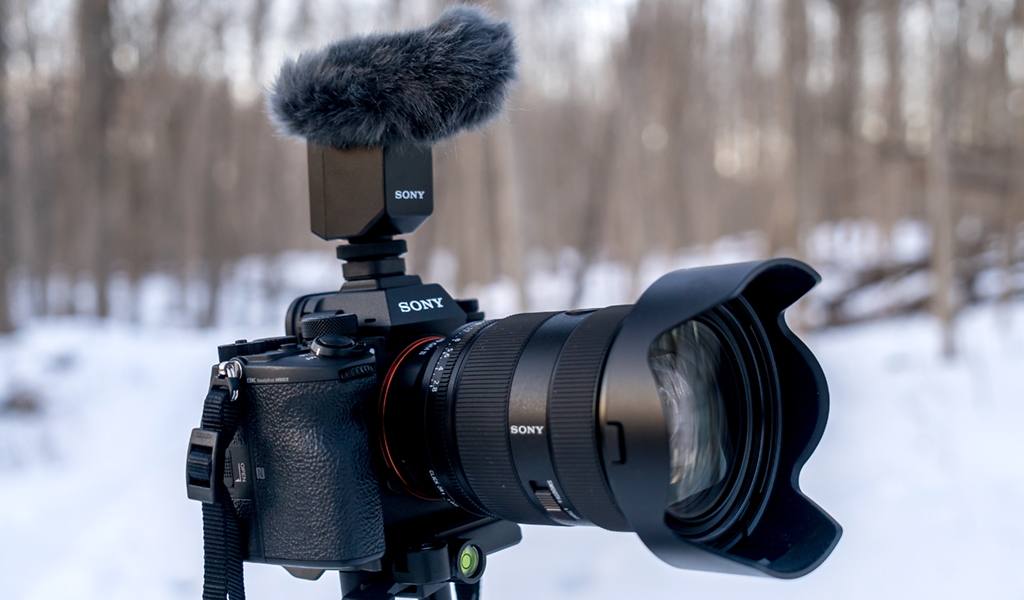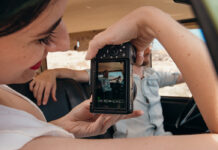
Sony makes various microphones for people who use their mirrorless cameras to create video content. Which one is the best fit depends on you. The four models in this review serve the same general purpose without doing it the same way.
I’ll try not to confuse you the way Sony can with its odd naming conventions for its products. I had to keep track of them myself to test this quartet of mics, but as I’ll point out, a couple of them can also work together for a better piece of kit.
Two are what are called “shotgun mics” that mount on a camera, whereas one is a wireless transmitter/receiver combo, and another a lavalier mic to clip yourself or a subject. Off the bat, it’s important to note three of these microphones only work with compatible Sony cameras. That’s not an extensive list, but the A7 IV and up are covered. As are the Alpha 1, Alpha 9 and ZV-E10. There are workarounds for other Sony cameras, which I’ll get to, but the compatibility part of this equation is important.
Riding shotgun with the ECM-B10

The B10 is a good example of what I mean. Compatible cameras have Sony’s own proprietary Multi Interface hot shoe, where you slide and lock the mic onto the shoe to drive both power and functionality directly with the camera. This connection means the camera recognizes the B10 and routes sound through the mic rather than its own internal mic.
Being a shotgun mic, it primarily focuses on capturing sound in front of it, though controls in the rear offer some options. You can switch between super, uni and omnidirectional. Super will pull in sound from a tighter cardioid position, while uni will expand the position laterally. Omnidirectional will capture anything from any direction. You can apply some noise-cancelling, if necessary with the NC or LC switch. To really snuff out some of the background noise from wind outside, the mic comes with a wind screen (or dead cat, as some call it) you can wrap on it.

The digital-analog switch is simple too. Digital works straight from the Multi Interface connection in the hot shoe. While analog could help the mic work with Sony cameras that don’t have the Multi Interface shoe, I found the B10 worked best when I used it with the Sony Alpha 1 camera rather than the A7 III.
You can choose to manually set the audio levels or keep them in auto. I preferred manual, personally, letting me adjust the gain, though I kept the attenuator at the recommended 10dB most of the time.
In the field
This is a powerful mic, and one that I can see really working for vloggers or journalists who tend to use their cameras while talking. The uni and omnidirectional settings can work well to capture both your voice behind the camera, as well as whomever is in front. Uni also works better to capture two voices in front, where two subjects might be talking to each other. It’s hard to drown out the background entirely, but the Noise Cut (NC) and Low Cut (LC) settings do an admirable job, only made easier the closer the subject is to the camera. I can see this setup working well if you’re using the camera with a gimbal where you want to keep sound focused on one or two people, including yourself if you’re doing vlogging videos.
It’s hard for me to quantify the distance, but suffice it to say, the B10 is like other shotgun mics in that it works best in closer proximity to the camera. Journalists will like it for its versatility in capturing sights and sounds with little effort, making interviews easier when propping the camera on a tripod. It’s not the cleanest sound I’ve heard from a mic, but it’s impressive, especially considering how small and compact it is.
More affordable with the ECM-G1

The ECM-G1 is a step down in that it won’t give you all the granular controls. You can’t adjust audio levels or switch between different modes. It’s a straight-up shotgun mic that uses the same Multi Interface shoe and records in an omnidirectional way. This means it will pick up sounds around you without much control over it, though you can muffle some of that with the wind muff/screen.
It wobbles at the base on purpose to let it roll with any camera movement, but its biggest value add has to be its diminutive size. This thing is small enough that you could be in danger of losing it. Hence, a carrying pouch comes in the box to stop that from happening.

While it was built to work with Sony cameras using the MI shoe, you can also use it with others through the Mic Out analog connection. The short cable for it comes in the box, enabling you to use it that way, only bear in mind that it draws its power from the hot shoe, so its versatility won’t extend very far beyond Sony’s cameras.
I liked the size the most, and found the G1 pretty adept despite its limitations. I can see this working when you have modest needs, or are just starting out. But if you want more control over how to tailor that sound, the B10 is the better bet.
Going wireless with the ECM-W2BT microphones

The W2BT takes things in a slightly different direction in that you have a wireless pairing between a receiver that sits on the MI shoe, and a microphone transmitter you can clip onto yourself or a subject. The two work on battery power and automatically link to each other wirelessly with a range of up to 600 feet. This is great for those times when you want to more freely move around, or are working with someone who will control the camera or be in front of the camera.
The receiver itself also has a microphone. That’s why there are three settings: Receiver will only pick up sound from the transmitter, Mic will focus on the receiver’s mic, and Mix will record from both simultaneously. This is great for vlogging and interviews because you can set things up how you want. Hold the transmitter like a handheld mic when speaking with someone, or plug in a handheld mic to it through the Mic Out port.
I liked the idea of combining the W2BT microphones with the LV1 because they were so easy to put together. Being a lavalier mic, the LV1 plugs in directly into the transmitter’s Mic Out port, and that was it. You can do the same with the receiver by plugging in directly to its own Mic Out port and setting the switch to analog.
Unfortunately, a corrupted memory card ruined my initial video testing out this combo. I also ran out of battery in another case. There is a hissing sound that can sometimes stand out in the resulting audio. Plus, it matters how close you place the mic to your mouth, as the mic can pick up background sounds or the acoustics of a room as well.
Plugging in with the ECM-LV1

I’ve already gone into the LV1 a little, but it’s the only one of the four microphones not tied to any specific Sony cameras. You can use it with any camera directly or with any transmitter/receiver combo, even if it’s from another brand. That’s great if you already own something that would work with something like this, as compatibility only requires that whatever you’re plugging into has a microphone port.
At first glance, it might appear that you need to place it horizontally to capture stereo sound properly but that’s not always the case. It’s omnidirectional out of the box, so it can pick up sound from any angle. For voices, though, it’s best to clip it on horizontally to make sure everything is level. It’s also the only one here that can work with smartphones and computers, making it ideal for video calls.
If you’re interested in the W2BT, I would strongly consider picking this up as well because the combination works so seamlessly. Plus, the LV1 is far less conspicuous compared to the W2BT’s transmitter.
Final thoughts
Good audio matters as much as a good picture does. No matter how sharp, crisp and colourful a video, if the sound is terrible, it’s hard to watch and pay attention. That’s why microphones are game-changers for producing quality content.
The thing about these microphones is they don’t really work with other camera brands. The LV1 is an exception because it’s a lavalier that only needs to plug in to a camera or wireless transmitter, but otherwise, Sony keeps them in a walled garden. That’s great if you have the right camera for the job, but if you don’t, you can always find something compatible elsewhere. The Multi Interface shoe is a unique feature in its own right, and a fairly recent one, which is why only select Sony cameras have it. Those that don’t wouldn’t be able to get the full experience from these, save for the LV1.
You can check out the Sony ECM-B10, ECM-G1, ECM-W2BT and ECM-LV1 available now. For the latest Sony cameras and lenses, look no further than here.



